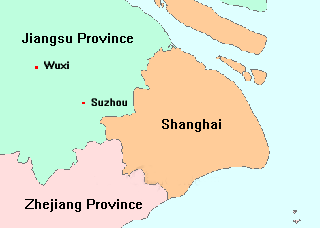Shanghai Life
 Shanghai, its name literally meaning "on the sea", is located on the east coast of China at the mouth of the Yangtze River. Like the rest of China, Shanghai is eight hours ahead of GMT. The entire administrative area of the city, including its surrounding suburbs, townships and farmland, covers a total area of 6,341 square km (2,448 square miles ).
Natives of Shanghai consider themselves to be the most cosmopolitan people in China and the trendsetters of the country. Reflecting its vibrant past, the city has some interesting nicknames, including "Paris of the East", "Queen of the Orient", and even 'Sin City' during the era of gangs and casino dens in the 1920s.
Shanghai, its name literally meaning "on the sea", is located on the east coast of China at the mouth of the Yangtze River. Like the rest of China, Shanghai is eight hours ahead of GMT. The entire administrative area of the city, including its surrounding suburbs, townships and farmland, covers a total area of 6,341 square km (2,448 square miles ).
Natives of Shanghai consider themselves to be the most cosmopolitan people in China and the trendsetters of the country. Reflecting its vibrant past, the city has some interesting nicknames, including "Paris of the East", "Queen of the Orient", and even 'Sin City' during the era of gangs and casino dens in the 1920s.
Shanghai began as a fishing village in the 11th century. By the mid-18th century, it was an important area for growing cotton and by the 1800s, it was becoming the largest city in China. Foreigners came into Shanghai due to foreign trade after the Opium Wars. The British, along with the Americans and French, were allowed to live in certain territorial zones without being under the Chinese laws. As a result of all the foreigners, Shanghai became greatly influenced by Western culture.
After the end of Shanghai's subjugation by the Japanese, the Nationalist Chinese government was given control of the city. The foreigners no longer had control and by 1949, Shanghai was transformed by the Communist Chinese government. As the foreigners left, the businesses that were left behind were one by one taken over by the government. After losing ground during the Cultural Revolution from 1966-1976, Deng Xiaoping's "Open Door Policy" allowed for the advancement back to being an international force in business and finance.
Shanghai is situated at 31'14' north latitude and 121'29' east longitude in
central-eastern China, along China's coastal line, facing the East China Sea
at the mouth of the Yangtze River. Connected with Jiangsu and Zhejiang provinces
in the west, the city is bordered by the East China Sea in the east, and the
Hangzhou Bay in
the south. North of the city, the Yangtze River flows into the East China Sea.
Hence the name of Shanghai means 'on the sea'.
Except for a few hills lying in the southwest corner, most parts of the Shanghai
area are flat and belong to the alluvial plain of the Yangtze River Delta.
The average sea level elevation is about four meters. With many rivers and
lakes scattered throughout, the Shanghai area is known for its rich water resources.
Most of the rivers are tributaries of the Huangpu River. Originated from the
Taihu Lake, the 113-kilometre-long Huangpu River winds through the downtown
area of the city. The river ranges in width from 300-770 meters, with an average
width of 360 meters. The ice-free Huangpu River is the main waterway in the
Shanghai area.
Shanghai's environmental quality has largely improved over the past six years,
with green space in the city center reaching 11 square meters per capita. The
city, named "National Garden City" by the Ministry of Construction,
has established 14 large parks over the past six years and a total of 4,168-hectares
of green-space within the Outer Ring Road. Besides the typical dangers of living
in a big city, Shanghai offers a relatively safe environment for people worldwide
to travel and live.
Today, Shanghai is the largest commercial and financial center in China. It
also has the largest port and largest industrial base in the Nation. In China,
there are 166 different kinds of industry, 157 of which are in Shanghai. The
primary industry in China is iron and steel. Oil and chemistry industries are
developing at a high speed, and now include more than 20 specialized fields.
Shanghai Oil and Chemistry Factory, which is in Hangzhou bay, processes 8 million
tons of chemical raw materials each year and now has become the biggest polyester-producing
base in China. Shanghai has the best shops and restaurants in the country and
the most fashionable people. It's the leading force driving the Chinese economy
forward. With its grandiose colonial buildings, ultramodern skyline and hyperkinetic
downtown streets that mix East with West, Shanghai will continue to grow as
a city.
|